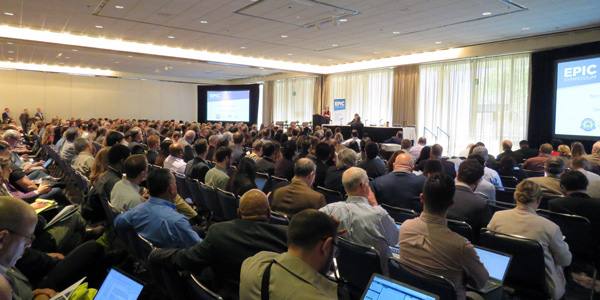By Jason Fordney
SACRAMENTO, Calif. — Nearly 600 people crowded into the California Energy Commission’s EPIC Symposium on Wednesday, doubling attendance from last year.
It was a testament to the widespread interest in securing the hundreds of millions of dollars in grant funding California makes available to research and deploy innovative energy technologies.
Funded through a charge on utility electric bills, the CEC’s Electric Program Investment Charge program was designed to provide $162 million annually from 2013 to 2020 to bring innovative technologies to market. The California Public Utilities Commission created the initiative in December 2011 to promote clean energy technologies, reliability, lower costs and safety. About $130 million of the annual funds are administered by the CEC.
State Sen. Nancy Skinner (D) told a packed room that the EPIC program is a way to explore and develop energy storage technologies that can reduce the curtailment of renewables and foster other efficiency improvements.
“We want to wrestle every bit of output from each unit of electricity or energy we produce,” Skinner said, discussing how her 2010 legislation, AB2514, fostered storage deployment by requiring the CPUC to consider mandating storage procurements for investor-owned utilities. “IOUs bought more storage and the price of storage came down. We want it to come down further.”
“EPIC has contributed to the development of numerous green technologies and facilitated the creation of thousands of jobs,” State Assemblymember Autumn Burke (D) said.
The CEC marked its third iteration of the EPIC program when it submitted its 2018-2020 Triennial Investment Plan last spring. The document lays out in detail the commission’s strategy over the three-year period for allocating the funds provided through EPIC, promising more coordination with local governments and enabling market growth of distributed energy resources.
“When we look at EPIC 3, we are really kind of thinking of that next generation of grid technology,” said Daniel Ohlendorf, Pacific Gas and Electric’s senior manager of electric emerging technologies.
“Electric vehicles and storage continue to be very important to us,” he said, as well as new maintenance approaches using new technologies such as augmented reality (computer-generated imagery) and drones.
Utilities at the symposium also discussed the growing pains associated with implementing storage technology. PG&E’s Morgan Metcalf described the challenges of behind-the-meter implementation.
“Figuring out how to use all these resources is an important next step,” Metcalf said. “It’s not just policy that is driving this, it is our customers as well.” She added that PG&E customers are increasingly exploring solar, electric vehicles and energy efficiency.
Southern California Edison, Lawrence Berkeley National Laboratory, the University of California Berkeley and a diverse group of companies and energy organizations also held panel discussions at the symposium, with a strong focus on engineering issues, new technologies and applications such as food production.
Feb. 20 Deadline
The EPIC program is actively soliciting applications for a $15 million “Bringing Rapid Deployment to Green Energy” grant, which includes $10 million in applied research and development and $5 million for technology demonstration and deployment. Open until Feb. 20, the CEC developed the solicitation to provide follow-on funding for “the most promising energy technologies” that have previously received an award from an eligible state or federal agency for research, technology demonstration and deployment.
“The purpose of this solicitation is to fund applied research and technology demonstration and deployment energy efficiency projects that will allow researchers to continue their technology development without losing momentum or pausing to fundraise from private sources,” the CEC said. The grant is focused on advancing technology to commercialization, and is not open to public and private universities, national laboratories, utilities, private nonprofit research organizations and technology end users.






